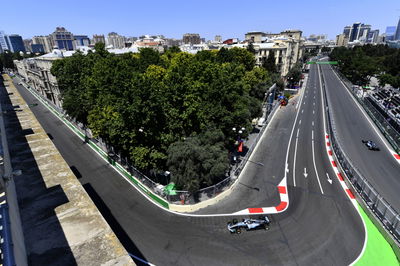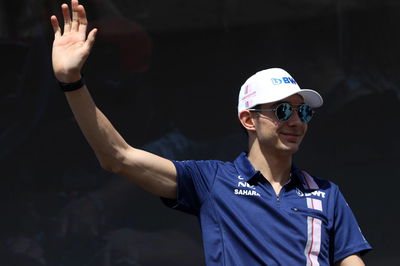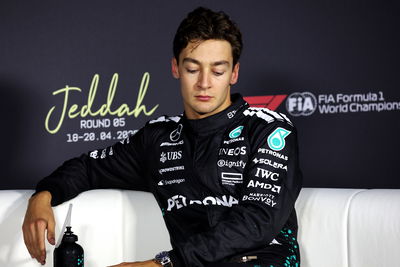After 2017 stunner, Baku looks to write more F1 history
The winter break offers Formula 1 fans and pundits the perfect chance to reflect on the season that has passed and pick some of the key points and highlights from another great year of grand prix racing.
And it all of the end-of-year reviews for 2017, there is one race that will keep coming up time and time again: the Azerbaijan Grand Prix in Baku.

The winter break offers Formula 1 fans and pundits the perfect chance to reflect on the season that has passed and pick some of the key points and highlights from another great year of grand prix racing.
And it all of the end-of-year reviews for 2017, there is one race that will keep coming up time and time again: the Azerbaijan Grand Prix in Baku.
From Daniel Ricciardo’s stunning triple-overtake en route to a shock victory to the dramatic clash between title rivals Lewis Hamilton and Sebastian Vettel behind the safety car, and even Lance Stroll’s surprise podium for Williams, the race was packed with outstanding moments that will be remembered for years to come. It had everything that makes F1 great.
It was a race that cemented Baku’s place in modern F1 folklore at just the second running of the grand prix in Azerbaijan. And it is something chief race promoter and Baku City Circuit executive director Arif Rahimov revels in.
“I would say we were probably the best race of the season. I don’t think we had as much action in any Formula 1 race for the past… I don’t know how many years!” Rahimov says.
“It’s hard to think of a season where we had as many accidents and red flags and safety cars and everything. And an unexpected ending. We had Daniel Ricciardo win the race, which was good because it wasn’t the normal result for this season - Lewis Hamilton or Sebastian Vettel winning - so it was great.”
The challenge for Baku’s organisers heading into 2018 will be to do everything in their power for a similarly successful and entertaining grand prix, keeping the momentum going after a breakout year.
“We had a brilliant year two, a lot of action, action-packed race, really good. For year three I just hope that we can keep up,” says Rahimov.
“It’s not up to us entirely, but I hope we can keep up with the action on the track. We’re trying our best to do as much as possible off the track in terms of entertainment. We have a huge fan area packed with entertainment. We have night concerts that we’re moving indoors for next year because of uncertainty about the weather.
“The most important thing is to entertain the crowd, the TV audience, the people who are on the track with great, amazing action. The first year was a bit quiet. Drivers were getting used to the track, trying to figure out different corners. They didn’t have their sims, they weren’t as developed in year one as they were in year two, so they were coming to the track thinking that they knew it much better, and that proved to be a great race.
“My plea to the drivers is to risk it and go for it, and provide this massive amount of entertainment to the audience like they did in 2017.”
The 2017 race was one that not only put the grand prix itself on the map, but also Baku as a destination for fans looking to visit from overseas, something Rahimov and his team have been keen to develop by combining the historic city’s vibe with a high-speed, challenging race circuit.
“Fans know that they’re going to come to this race, it’s not going to be boring. They’re going to have fun watching the race, and they’ll definitely be more inclined to go even through sometimes the challenges of getting here,” believes Rahimov.
“If they’re a true fan, they’ll make sure they want to visit the most interesting race. It helps with the international fanbase because that’s one of our main targets. We want to increase it year-by-year to make sure we’re having more tourists coming to the country and specifically for the race as well.”
Baku more than doubled its attendance from 2016 to 2017, with the gate figure reported by F1 rising from 30,000 to 71,451, acting as a good-news story at a time the sport is working hard to capture new fans and increase its reach.
Attempts at doing this have been evident at races in the United States and Mexico, marking a change in F1’s approach as it looks to “put the spectacular back into the spectacle”, in the words of commercial boss Sean Bratches.
Baku may be a new race, but it is already working hard on new ideas and ways of also capturing the imagination of a burgeoning F1 fanbase while also retaining unique qualities.
“We’re constantly brainstorming on the new things that we can speak to Liberty Media about, such as the protocol of the race and how it is structured,” says Rahimov.
“For the time being it’s quite raw, but I think we’ll think of new ways to make it more interesting, like they did in Austin. We had the drivers during the national anthem, and it was structured in a different way. In Mexico with the podium DJ set, that was absolutely great.
“We’ll try to think of new things. I cannot tell you for sure now what it’s going to be, but we’re constantly brainstorming and trying to find some new approach to what’s been done already.”
At a time when Liberty Media is openly courting a number of the world’s destination cities to stage an F1 event and expand the sport’s calendar, there is a greater need for races to stand out, much as Baku did in 2017. This is a challenge Rahimov recognises, but feels Liberty also allows and encourages.
“Of course, especially with the new races because people know what to expect from the old ones - they know the circuit, the drivers know the circuit,” Rahimov says.
“With the new races, this is the unknown territory. You can see the unexpected, you can see the new circuits. But it’s going to be more of a big deal to actually do something that’s different.
“On the good side, Liberty allows that. Liberty Media allow something different throughout the race weekend, so now it’s up to promoters’ fantasies and creativity to ensure that they can stand out, which is good.
“It’s giving more freedom for the promoters to sort of improvise and bring something new to the race.”
One of the greatest challenges for any new race is to use it as a catalyst for a stronger national motorsport culture. In a country of the size and population of Azerbaijan, the task is only heightened - but already progress is being made and encouraged.
“What we’re doing right now is launching a good semi-professional karting circuit in Baku,” confirms Rahimov.
“We’re directly involved in this karting circuit; I think this can be a good kick-starter for the youth motorsport community. We already have an indoor karting circuit but we have now, we’re going to now have an outdoor semi-professional proper track.
“And maybe then we can see some talent, send them to participate in F4 races. There’s a good championship right now in Russia, the SMP F4. We’ll see how it goes.”
Another way to use motorsport to capture the attention of a nation was seen earlier this year when F1 Live hit the streets of London. More live events are planned through 2018 and are now actively encouraged by the sport’s rules, giving Rahimov hope of someday bringing something similar to Baku.
“It would be great to have this maybe a week before the race. It would be a good promotion for the race itself and it will be a Formula 1 event in the city which is more bringing the fans closer to the cars and to the drivers,” Rahimov says.
“We spoke to Formula 1 about this. Maybe we can do something closer to the weekend so we can use the infrastructure that’s already there to host that.
“But overall I think it’s a great idea, and the way they’ve changed the rules for the demo cars - that you can actually use the current cars in those demo runs - is actually great because fans can actually see them, and not the two- or three-year-old cars but the current cars running through the cities.
“I’d love to have something like that in Baku.”
But it is the drivers in F1 themselves that fans really look up to. Ricciardo’s stunning charge to victory in Baku last year saw one of the sport’s most marketable and visible figures hit the top step of the podium, with Rahimov recognising the importance of having good characters when trying to promote the F1 race.
“100 per cent. People love teams, but I think they love racers much more than they do love teams,” Rahimov says.
“It’s not a secret that having personalities racing that have this great character and great atmosphere around them, it’s really important.
“I think it helps a lot to have people like Dan, like Lewis, like Max [Verstappen], like Fernando [Alonso].
“It’s great because they’re more than just drivers, they’re personalities.”
All of these personalities are set to come back out to play in Baku next April when F1 ventures there for a third time, and if the 2017 race is anything to go by, we could be set for another spectacular, unique event.
Baku may not have a rich motorsport history, but it is quickly starting to place itself in the modern tapestry of F1. It will always be remembered as the track where the 2017 title was arguably decided, offering a crucial swing in the fight between Vettel and Hamilton.
It is surely just a matter of time before more history is written around the streets of Baku.











